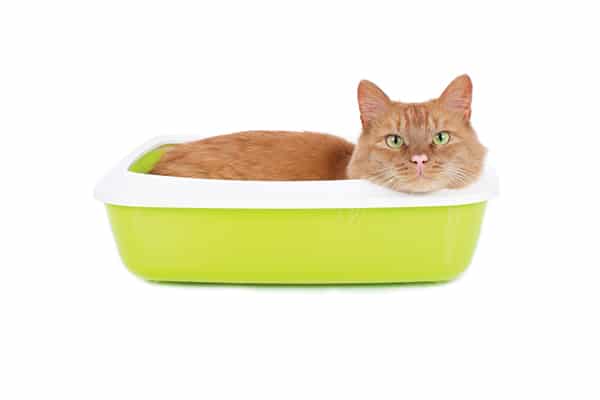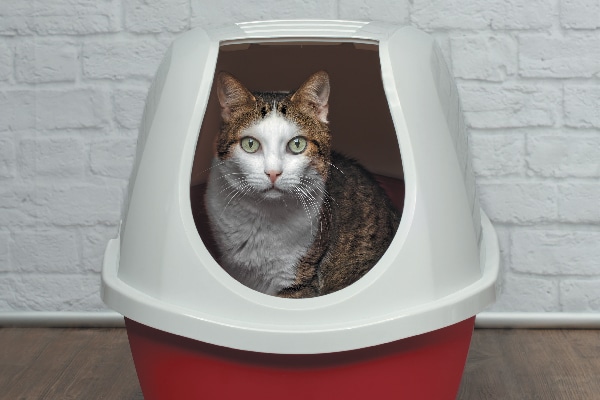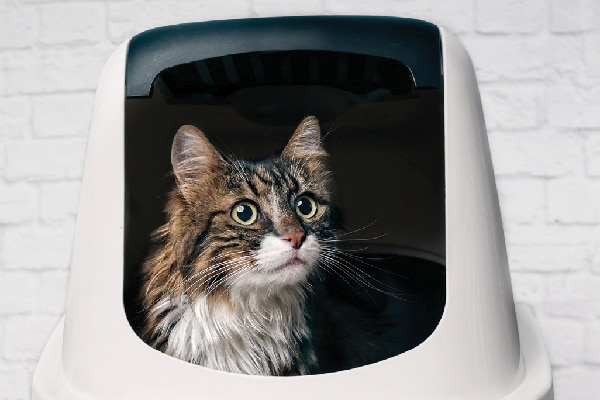Go to any pet supply store and it’s easy to feel overwhelmed by the wide array of cat litter options. All those options make it hard to know which litter is best. Here’s how to pick the right cat litter for your cat.
What are the common cat litter options?
The most common litter is clay clumping litter, though other kinds of litter are increasingly gaining popularity. Options beyond clay include wood shavings, silica crystal-like, wheat, corn, or recycled paper.
Related: 6 Alternative Types of Natural Cat Litter
“The choice of material mostly comes down to your cat’s personal preference; some cats simply prefer certain types of litter over another,” says Dr. Jamie Richardson, Medical Chief of Staff for Small Door Veterinary.
Are there any safety concerns?
Even though cats are not consuming their cat litter, they come in close contact with it. They end up inhaling dust and other particles that come off the litter, which can lead to health conditions. Unfortunately, some litter additives like fragrances, designed to make cat litter more attractive to people, can be harmful to cats.
“Whichever material you choose, we recommend choosing a litter that is unscented and dust-free, as cats can have very sensitive respiratory tracts that are easily irritated,” says Dr. Richardson.

What you find in your cat’s litter box can indicate if he’s healthy — or not. Photography by Absolutimages/istock.
What should I consider?
Although cats’ personal preferences are often the primary consideration for what litter you pick, if your cat has underlying health conditions, you may need to take those into account.
Specifically for cats that are recovering from surgery, Dr. Richardson discourages the use of clumping litter because “it can get stuck in the wound, risking infection.”
For cats who have allergies or respiratory issues, the litter you use must be unscented and dust-free to prevent triggering symptoms. For instance, Dr. Richardson notes that if your cat’s allergies include pollen, grain, dust or mold, you should pay attention to ensure the litter you choose doesn’t trigger an allergic reaction.
“Pine litter can work well for cats with grain or household allergies, or grass-seed litter is 99% dust-free, for those with dust allergies,” Dr. Richardson says.
Here are symptoms to look for if your think your cat litter is making your cat sick
Cats can dislike certain sorts of litter, and some litter can even make them ill. Cats who dislike the litter in their box will generally make this clear by urinating or defecating in other areas of the house or outside the box. Dr. Richardson did also point out that while this behavior might be your cat making their displeasure known, these are also common symptoms of “anxiety issues or health problems such as UTIs, so it’s also important to get them checked out by a veterinarian.”
Beyond disliking certain kinds of litter, cat litter can actually make your cat sick. Dr. Richardson advises that signs to watch for include
- “Runny” nose (discharge from nose or nasal congestion)
- Red, irritated, itchy or watery eyes
- Itchy skin and/or excessive scratching or grooming
- Facial swelling
- Wheezing, sneezing or coughing
All of these could be signs that your cat is allergic to the litter that you have been using. If your cat experiences these symptoms, it’s a good idea to connect with your vet and explore making a change.

Some cats are very picky about what kind of texture they prefer to walk on and use, and you might have your own preferences such as cost, ease of access to purchase or how biodegradable the litter is. Photography ©St_Aurora72 | Getty Images.
Why you may need to try a few types of cat litter
Some cats are very picky about what kind of texture they prefer to walk on and use, and you might have your own preferences such as cost, ease of access to purchase or how biodegradable the litter is. I would love to use a different and more environmentally friendly litter than I use, but I have a 21-year-old cat who has made very clear that there is one brand of litter and one brand alone of litter that she will use, and so, we purchase it. To find the right litter that you and your cat can agree on, you might have to do a little bit of trial and error.
“You may need to try a few types to find your cat’s favorite, so we recommend buying small quantities to begin with. If they don’t seem to like their existing litter, you can try putting down two or three litter boxes with different litter types to let them choose,” says Dr. Richardson.
If you are adding a new cat to your home
If you are bringing a new cat home, Dr. Richardson advises that you continue to use the kind of litter that they are familiar with to start with. This will help your new cat or kitten to have an easier time adjusting to your home and family. If once your new cat is used to your home and family, you want to utilize a different litter long-term Dr. Richardson encourages you to make the change gradually by “introducing small quantities of the new litter with the old one.” It’s important to avoid quickly changing your cat’s litter as it would result in stress for your cats and could also lead to behavioral issues, including your cat refusing to use the litter box.
Multi-Cat Homes Considerations
Litter box choices are crucial when you are living in a multi-cat home. Besides needing to have multiple litter boxes so that each cat has access to its own, different cats may have different preferences. Dr. Richardson notes, “you may need to buy different types of litter for each cat. (It’s best practice to have at least one litter box for each cat in the home anyway, so they feel comfortable going in their own space).”
Related: How to Introduce Your Cat to a New Cat
Litter Box Best Practices
The amount of litter in each box is also essential and might contribute to your cat’s willingness to use the litter. “It’s important not to over- or underfill the litter box. Cats like to have enough litter to cover up their feces, but too much can spill out of the box. A good rule of thumb is around two inches of litter, ensuring there is enough space at the top of the tray that it won’t overflow when your cat steps across it,” suggests Dr. Richardson.
Litter boxes should be kept in quiet areas of the home so that your cat will feel comfortable using them. Regardless of what litter you and your cat select for you to purchase, it’s important to maintain a clean box. Dr. Richardson notes that a daily cleaning of a litter box should be considered a minimum. Ideally, fecal matter is removed after each bowel movement and urine-soaked litter is removed daily, with the whole box being emptied and scrubbed with hot water weekly.
Featured photo: ©Lightspruch | Getty Images.
Read Next: 10 Weird Cat Litter Box Habits
